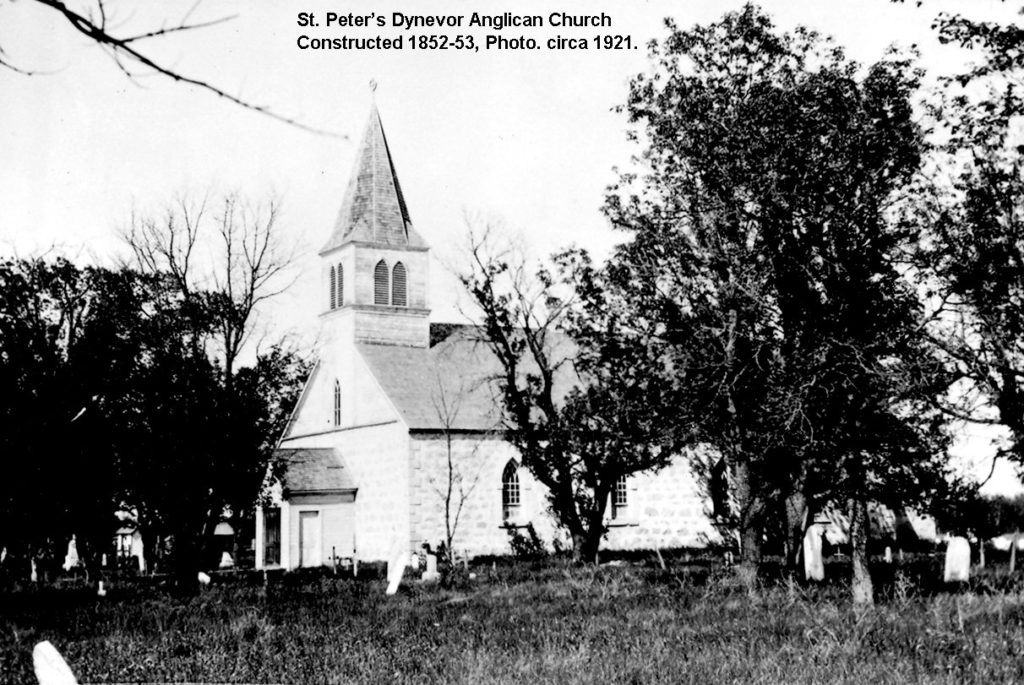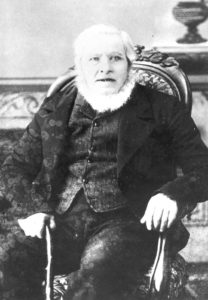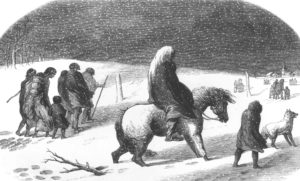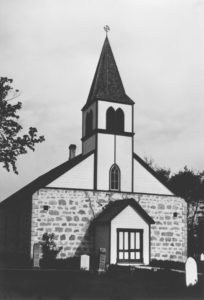Where is the church of St. Peter, Dynevor?
The Church of St. Peter, Dynevor stands on the east bank of Red River, three miles north of East Selkirk, at the mouth of Cook’s Creek in the rural municipality of St. Clements. It is the second oldest stone church in Manitoba, and in western Canada.
-
When was the church built? What was it made of?
The idea of building a new church first surfaced in December 1851. Members of the community gathered with the local minister, Rev. William Cockran, to discuss the possibility. The people wanted a church that would withstand the extreme temperature changes of the region, bear up against the busy activity of its parishioners, and become a sacred gathering place that would survive for generations. To meet these requirements, the people decided to build the church from limestone, a material that was durable, plentiful, and local.
As the snow melted and the weather warmed in the spring of 1852, quarrymen began to dig limestone from the riverbank and nearby quarries. They loaded it onto horse-drawn wagons and hauled it more than 12 kilometres (8 miles) to the building site. At least 80 cords of limestone went into the foundation and walls of the building. A cord measured 4 metres long (12 ft), 2 metres wide (6 ft) and one metre high (3 ft). It took several men working long hours and many days to complete this task.
In the spring of 1853, stoneworkers had hauled enough limestone to the site to begin building. Surveyors staked the location and measured out its dimensions of 70 ft (a little over 23 metres) in length and 40 ft in width (14 metres). Sawyers dressed the limestone foundation stones into long rectangular shapes and Fixer-masons placed them 4½ feet into the earth. The walls rose up off the foundation stones. By the fall of 1854, the exterior was nearing completion when cedar shakes (shingles) covered the rafters. Workers then turned their attention to the interior of the church.
How did the church get its name?
David Anderson Bishop of Rupert’s Land, gave his blessing and named the building, St. Peter, on 23 May 1853. The name, St. Peter, derived from the ancient apostle Saint Peter, known as Simon Peter of Cephas. He was one of twelve apostles of Jesus, and according to tradition the first Bishop of Rome. Throughout its history, the church has received other names too: St. Peter’s Church, St. Peter’s Parish Church, The Parish Church of St. Peter, the Anglican Parish Church of St. Peter, and the Old Stone Church of St. Peter, Dynevor.
Who were the builders of the church?
The builders of the church were mostly men, although many women contributed food, money, and supplies. Women also donated their time and skill cooking and preparing meals for the workers.
The men who worked with the stone were stonemasons. There are several different kinds of stonemasons:
– Stonemasons work with stone
– Quarrymen split rock and remove it from the earth
– Sawyers cut the rough stone into cube rocks and shape them into squares, rectangles, or whatever shape is needed
– Fixer-masons fix stones together into buildings, around door frames and window frames
The basic tools of a stonemason included a mallet, hammer, chisel, and a trowel.
Duncan McRae
- Duncan McRae was the main stonemason who oversaw the work at St. Peter’s Church.
- Born in Melbost, Stornoway, Scotland in 1813
- Duncan grew up learning the art of stone masonry
- At twenty-two, he married Charlotte Smith (1835)
- He became a stonemason for the Hudson’s Bay Company
- At 24, the Company sent him, and his family, to Red River Settlement (Winnipeg)
- They came by sailing ship across the Atlantic Ocean to Hudson Bay
- Fathered at least 12 children
Duncan assisted in the construction of some of the stone walls and buildings at Lower Fort Garry and the rebuilding of the north wall at Upper Fort Garry. He assisted in the building of several stone churches and buildings throughout the settlement including the second Cathedral of St. John (Winnipeg), Kildonan Church (Winnipeg), St. Andrew’s Church and Rectory (St. Andrews), St. Peter’s Church (East Selkirk), Little Britain Church (Lockport), and Twin Oaks School (St. Andrews).
He fell from the roof during the building of St. Andrew’s Church causing serious injury to his leg. Consequently, he needed a cane to help him walk and for the last fifteen years of his life, he was unable to walk. Duncan and Charlotte McRae lived on a farm in St. Andrews for fifty years. Charlotte died in 1895; Duncan died on 4 February 1898. Their bodies were buried in the cemetery at Little Britain Church (Lockport).
John Clouston
John Clouston came from Scotland in 1837 with Duncan McRae. For a time he was secondary stonemason to Mr. McRae helping with the building of St. Peter’s Church, St. Andrew’s Church, Little Britain Church, and the walls at Lower Fort Garry. He also did stonework on St. Clement’s Church with stonemason Samuel Taylor.
General labourers/contributors
Many people contributed to the building of Peter’s Church. According to a journal written by Rev. William Cockran, the first missionary to preach at the church, the following families contributed money, labour, supplies, and food: Anderson, Asham, Badger, Bear, Cadotte, Cameron, Cockran, Cook, Donald, Flett, Johnstone, Henderson, Kennedy, King (Chief Peguis), Kirkness, Prince, Sandison, Sinclair, Smith, Spence, Stevenson, Stranger, Tate, Thomas, Turner, Whiteford, and Williams.
Rev. William Cockran
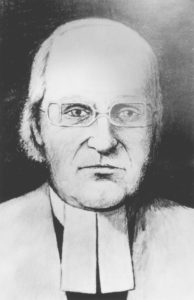
- Rev. William Cockran
– Born in 1798 in Chillingham, Northumberland, England – a border town between Scotland and
England
– He referred to himself as a Scotsman
– He was a big man, reports suggest he stood seven feet tall and weighed about 300 pounds
– Studied Christianity at the Church Missionary Society College in England
– Ordained a Deacon in 1824 and Priest in 1825
– Became an Archdeacon in 1853
– Died 1 October 1865
The Church Missionary Society trained men and women to do missionary work in foreign countries. They asked Rev. Cockran to immigrate to Red River Settlement in 1824 to serve the spiritual needs of the people in the region. He agreed and brought his wife Anne, and young son, Thomas, with him. After a fifty-two day passage across the Atlantic Ocean on the ship, Prince of Wales, they landed at York Factory, Hudson Bay and travelled the waterways south to Red River Settlement. Shortly after they arrived, Rev. Cockran met Chief Peguis, the legendary Saulteaux (Ojibway) leader at Netley Creek. They became friends, and together they developed the settlement of St. Peter’s.
Peguis, a Saulteaux man born on the St. Mary’s River near Sault St. Marie (Ontario) in 1774 was not a farmer, nor were his people. The Saulteaux people were trappers, hunters, and gathers, and lived a nomadic lifestyle for centuries. They immigrated to the region of Red River in the late 1780s from their homeland near the St. Mary’s River. They trapped beaver and muskrat in the local waterways and traded their catch for goods at the local Hudson’s Bay Company trading post. They spoke a different language to Rev. Cockran and were, at first, hesitant of his ideas to begin a settlement as the idea was very strange and different to their own traditions and customs.
Over time, Peguis and Rev. Cockran became friends. As the friendship developed, Peguis began to believe in the idea of a settlement for his band. He knew that the old way of trapping and hunting was vanishing. This resulted from centuries of over trapping. There were fewer and fewer animals to trap. Rev. Cockran showed Peguis and few of his men how to break and cultivate the ground and plant potatoes. He also showed them how to build a log house. More people joined the community. Almost all of them were of Saulteaux/Ojibway and Cree heritage and so the community became known as the Indian Settlement. In 1836, the community built a log church, but it never held an official Christian name. Peguis and Rev. Cockran were apart of the organizing committee for the new church in 1851.
Rev. Cockran also established two churches at St. Andrews. In 1832, he organized the building of the Rapids Church a log structure named after the set of rapids on the Red River. In the early 1840s, he designed a new church, a limestone structure named after Saint Andrew, the brother of Saint Peter. Construction took place between 1845 and 1849. Rev. Cockran died on 1 October 1865, at the age of 67, in Portage la Prairie (Manitoba). Friends carried his body to St. Andrew’s cemetery for burial, near the front door of the church.
How was the church built?
After quarrymen hauled the limestone to the building site, sawyers cut and shaped the stones to make them suitable for construction. Then fixer masons placed the foundation stones into the earth and placed layers of stones on top of them to build the walls. The walls reached a height of twelve feet above the ground. Using a technique called block and tackle stoneworkers raised the stones to higher levels by ropes and pulleys. As the walls rose, stoneworkers had to cut and shape the limestone to fit the corners, windows, and doorways.
Stoneworkers applied mortar, a glue-like substance made from lime and sand to the stones to hold them together. Stoneworkers made lime by crushing limestone into lumps of stone and loading it into a kiln (an oven for burning). Typically, the kiln took one day to load, three days to fire, two days to cool, and one day to unload. The burning removed the moisture to convert the lime into a good binding agent. The process was quite slow.
The Foundation
The foundation was more than one metre deep (4½ ft) and one metre (3 ft) thick. David Anderson, Bishop of Rupert’s Land, laid the first foundation stone on 23 May 1853 at which time he blessed the building and its people and gave the church its name, St. Peter. The shape of the foundation is rectangular, measuring 23 metres (70 ft) long and 14 metres (40 ft) wide.
Windows
Manufactured in England, the glass for the windows travelled in barrels of liquid molasses to protect the glass and prevent breakage as it made its way to the church. The molasses hardened before shipping, which supported the glass. Once the barrels reached the church, they were reheated to return the molasses to liquid form. Workers removed the glass, cleaned it, and placed it in the window frame.
The barrels that carried the glass were loaded onto sailing ships in England for the long passage across the Atlantic Ocean. The passage lasted about two months and could be very rough. Ships sailed through Hudson Strait to the southern coast of Hudson Bay, anchoring near York Factory, a Hudson’s Bay Company fur trade fort at the mouth of the Hayes River. The barrels were unloaded there and transferred to York boats, a common boat at that time used to carry freight and furs along the waterways between York Factory and Red River Settlement. Modeled after Orkney fishing boats with flat bottoms and pointed ends for easy maneuvering, the York boat got its name because of its frequent trips to York Factory. Workers built two sizes – the larger boats were 13 metres in length and propelled by eight oars. They could carry 100 pieces of freight and a crew of at least eight. When fully loaded, they weighed up to 5.5 tonnes. The smaller York boats had six oars and carried up to 70 pieces of freight.[6]
York boats carried the barrels upstream from York Factory, on the Hayes River, to the Echimamish River (known to the Cree people as the river that goes both ways.) to Norway House. They travelled a short distance on Playgreen Lake to Lake Winnipeg, sometimes called the Great Inland Sea. They followed the eastern shoreline for 402 kilometers (250 miles) to the mouth of Red River then paddled upstream to St. Peter’s Church. The crew delivered theglass after paddling, sailing, and sometimes portaging, the boats and cargo, a distance of 1,500 kilometers (950 miles) from Hudson Bay to St. Peter’s Church and Settlement.
The Roof
Eight metre-long log rafters made up the roof of St. Peter’s Church. Workers floated the log rafters down river from Red River Settlement. It was the easiest way to transport them. Once in place, the log rafters were covered with wood planks and cedar shakes/shingles.
The Bell Tower
A bell tower (or belfry) is a normal part of all churches, usually built over the front door, and designed to hold one or more bells. The bell tower at St. Peter’s is on the west end of the church above the front door overlooking Red River.For over 30 years, the original bell tower served the church, but it was dismantled in the early 1880s due to a safety issue. Workers built a new tower during the 1904/5 season to celebrate the 50th anniversary of the church.
Two bells hung in the tower throughout the 19th century. The larger of the two weighed 140 pounds. Cast in 1850 at Whitechapel Bell Foundry, England the bell arrived in North America as a gift from the Church Missionary Society. Whitechapel Bell Foundry is the oldest bell foundry in the world, established in 1570 in the reign of Queen Elizabeth I.
The second bell, dated 1857, was a little smaller at 112 pounds. Made by John Taylor & Co. of Loughborough Bell Foundry of England, the bell was given to Rev. Abraham Cowley when he and wife, Arabella, visited England in the mid 1850s. According to nineteenth century writings, the bells had the finest tone of all the Red River Settlement churches.
In December 1962, one hundred years following the creation of the church, thieves stole the bells. They unhooked the bolts that held the bells in place, lowered them 60 feet to the ground, and dragged them away on a sled. No one discovered the theft until a few days later. The community did replace the bells. One report says the people of St. Mary’s Church, Charleswood gave a new bell to the parish as a replacement, and the community ordered a second bell from a factory in eastern Canada. Other oral reports say the bells were returned. There are no identifying marks on the current bells to confirm their origin.
The Stone Fence
Stonemasons built a stone fence enclosing the church and part of the cemetery after the church was complete. Stonemasons dismantled the fence sometime after 1880 using the stones to build a chancel and vestry on the north side of the church. They inserted a stained-glass window into the east wall in memory of Archdeacon Abraham Cowley.
The Pews
The church holds about 72 hand-hewn wood pews. Rev. Cockran noted in his journal that some of the pews were a gift from the old wood church at St. Andrew’s (a.k.a The Rapids Church). Rev. Abraham Cowley had others built specifically for the church. The original pews are still in use today, painted brown and each one is distinctively one-of-a-kind.
The Pulpit and Altar Rails
The original oak pulpit and altar rails remain a part of the church today. Rev. Abraham Cowley had them made from local Oak trees.
How was the church heated?
Two wood-burning stoves with metal pipes running between the stoves heat the church. Originally, there may have been portable stoves as well. When the stoves are in use, the air near the pipes and stoves is very warm, but the farther one sat away, the colder the air. Many dedicated people have donated their time to cut and haul wood to the church over the last one hundred and fifty years. After the church was restored in 2002/3, the stoves and piping were replaced with more modern wood burning stoves.
Things of interest inside the church
The word Kanatiseyun sits high above the altar. It is a mix of Saulteaux (Ojibway) and Cree speech that translates into English to mean Holy or Clean.
Rev. Abraham Cowley held the first service in the church on 19 November 1854. According to his journal, he said the Prayers in the Saulteaux/Ojibway language and gave the service in both the English and Cree languages. He noted that the people sang hymns in all three languages. Betsy Hope and her son received the first baptism in the church on 19 November 1854.
Who was the church built for?
The church was built for those living in the region, peoples of Saulteaux and Cree heritage. In 1851, about 87 families (500 people) lived in the area.
Why was the church built?
The church was built to replace the former log church. Protestant missionaries had immigrated to the region from England to convert non-Christian peoples, especially First Nation peoples, to Christians. Initially known as the Indian Settlement, and later St. Peters, the community became one of the first western agricultural/Christian settlements established and run by First Nations peoples. The community thrived during the mid 1800s with homes, schools, blacksmith shop, flourmill, and retail merchants.
People connected to the church over the years
Rev. William Cockran: – see bio above
Chief Peguis (a.k.a. William King):
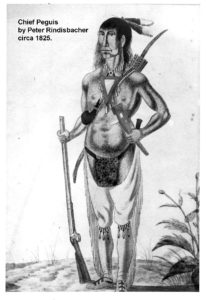
Saulteaux man, possibly Chief Peguis, Sketch by Peter Rindisbacher, Archives of Manitoba [click to enlarge]
Chief Peguis was buried in the cemetery of St. Peter’s Church in 1864. His life began in 1774 near the St. Mary’s River in modern day Sault Ste. Marie (Ontario)
- Born in 1774
- Mother: a young Saulteaux woman – name unknown
- Father: a French Canadian fur trader – name unknown
- Moved west with his Band to Red Lake, Minnesota (USA) then to Pembina, North Dakota
- Relocated to the forks of the Red and Assiniboine Rivers in the 1780s
- Settled on the banks of Netley Creek
- Established St. Peter’s Settlement, East Selkirk with Rev. Cockran
- Accepted the Christian name William King, his children took the surname Prince
- Died in 1864
Sketch by Peter Rindisbacher – possibly Chief Peguis
Chief Peguis came from generations of trappers, hunters, and gathers on his mother’s side. He trapped beaver, muskrat, and other animals and traded the fur at the nearest trading post for European goods such as muskets, knives, axes, tea, sugar, blankets, cloth, beads, and many other things. While still residing in his homeland, Peguis met and befriended several French fur traders. They called Peguis’ people Saulteaux (pronounced Soto) meaning people who jump or shoot the rapids because the people leaped and jumped across the rapids as they speared fish on the St. Mary’s River. Today, descendants called themselves Saulteaux, Ojibway, and/or Anishinaabee. Many French men formed marital unions with Saulteaux women based on Saulteaux marriage ceremony. Their children are the Métis.
When Peguis was a young man, he and his people could see the beaver vanishing in their region due to over trapping. As the French fur traders moved westward to find more, so did Peguis and his people. They reached Red Lake (Minnesota) and stayed for a few years then turned north up the Red River to where it meets the Assiniboine River (current city of Winnipeg, Manitoba). Continuing north, they settled their main camp on the banks of Netley Creek.
Chief Peguis and his people lived at Netley Creek for several years interacting with local fur traders, especially the French traders whom they had met at Sault Ste Marie. When groups of Scottish immigrants called, Selkirk Settlers, arrived in 1812, Chief Peguis and his people hunted for them bringing them food to eat when they had none. He gave them clothes and blankets to keep them warm, and snowshoes and moccasins to wear as they travelled in snow. For the first few years, the settlers relocated to Pembina (North Dakota) for the winter near the Hudson’s Bay Company post. Peguis and his band guided them there safely.
When the English missionaries arrived in the early 1820, Chief Peguis welcomed them to the region and spoke with them often through the aid of an interpreter about various spiritual matters. He was most interested in Spirit and spiritual related issues. The spiritual tradition of the Saulteaux was a form of Shamanism – an earth based spiritual practice that taught the connectedness of all things in the ecosystem and the universe. All things in Nature has a spirit, including the sun, moon, stars, water, wind, trees, plants, lightning, thunder, and all animals. They believed in an all-powerful Creator/God, and referred to that Creator/God in their own language. When they wanted to send their prayers to their Creator/God, they smoked the sacred pipe. When they needed to connect with that higher power, they played the sacred drum, offered tobacco, and performed sacred ceremonies.
Peguis held firm to his spiritual beliefs and traditions for many years, refusing to surrender to the teachings, religion and language of Christian missionaries. However, he was a deeply spiritual man and after much persuasion consented to Christian baptism as an old man. He accepted the Christian name, William King. Ten years after the church was complete, he died at the grand old age of ninety and was buried in the cemetery on 28 September 1864 three days after his death.
Henry Prince (Red Eagle/Mis-koo-kenew)
Born about 1824 in his parent’s camp along the banks of Netley Creek, Miskoo-kenew (Red Eagle) was one of the younger sons of Peguis. His mother’s name is unknown. He was cultured in the traditional ways of his Saulteaux ancestors and educated in Christian/European traditions at the mission school at St. Peter’s. He was baptized, Henry Prince in 1837. On 29 December 1840, he married Sarah Badger at St. Peter’s Church. He fathered at least six children with Sarah including William Henry (Rev.), John ‘Long Jake,’ Joseph, Jesse, Victoria, and Janie.
Henry became Chief of the St. Peter’s Band/Reserve after the death of his father, Peguis in 1864. In that position, he represented the Band when he signed Treaty One at Lower Fort Garry in August, 1871 claiming land in the region of St. Peter’s and Netley Creek on which his father’s Band had settled in the late 1780s. Henry Prince died on 7 June 1899 at the age of 75. He was buried the following day in St. Peter’s cemetery. His grave is unmarked.
What is a Treaty? From the Treaty Relations Commission of Manitoba
A Treaty is a formal agreement between two parties. The Numbered Treaties, which cover all of Manitoba, are formal agreements that created a relationship between the Crown and First Nations. As a result, each party has certain expectations and obligations, both explicit and implicit. The Numbered Treaties provided First Nations with such things as annuities, education, reserves and protection of their traditional economies, while the Crown acquired the means to open up territories, including modern day Manitoba, for settlement and agricultural and resource development.
First Nations and the Federal Government differ, however, in how they view Treaties – First Nations see the Treaties as covenants, while the Federal Government sees them primarily as contracts. First Nations believe that the Treaties are land sharing agreements, witnessed by the Creator, between two sovereign parties that established a permanent relationship. The Federal Government acknowledges their solemnity, but they view the Treaties as land surrender agreements whereby First Nations ceded their territories to the Crown. As well, First Nations believe that the spirit of the agreement is what is most important, including oral commitments, whereas the Federal Government believes the written text is what is most important.
Joseph Cook
Joseph Cook was the first school teacher at St. Peter’s Settlement, and a dedicated assistant to the various missionaries who came to the community. Born about 1790 to Kahnapawanakan, a Cree woman from York Factory, Hudson Bay, and William Hemmings Cook, a Londoner, who worked for the Hudson’s Bay Company, Joseph grew up in northern Manitoba during the peak of the fur trade.
He married Catherine Sinclair (daughter of Nahoway and William Sinclair) a Cree/Scottish woman with whom he fathered many children. After retiring from the company, Joseph and Catherine moved south to Red River Settlement and made their home at St. Peter’s Settlement. He was fluent in the Cree and English languages and said the church prayers in Cree for many years. He also translated services from English to Cree. He died in 1848 at the age of 60 years and was buried in the cemetery of St. Peter’s.
Rev. Abraham Cowley
Rev. Abraham Cowley became the clergyman of St. Peter’s Church in 1854. He took on the task of completing the church.
– Born in 1816 in Fairford, England
– Trained with the Church Missionary Society in England
– Wp style= ife: Arabella Sainsbury
– Arrived in Red River Settlement in the fall of 1841
– Established a Christian mission at Pinaymootang (Fairford, Manitoba)
– Relocated to Red River Settlement, St. Peter’s in 1854
In the early 1860s, the Cowleys built a two-story, Georgian style, stone, home across the river from St. Peter’s Church. They named it,
Dynevor in honour of Rev. Cowley’s mentor, Rev. Francis William Rice (1804-1878), later Lord Dynevor, 5th Baron Dynevor.In 1871, the St. Peter’s post office opened. The name changed to Dynevor five years later. The name Dynevor was used to identify the region throughout the later part of the nineteenth century, and the church became known as St. Peter’s Church, Dynevor. 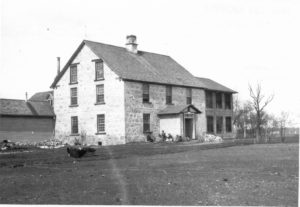
The Cemetery
According to records and oral story, there are at least 3,000 to 5,000 unmarked graves in St. Peter’s cemetery. St. Peter’s burial registry, housed in the Diocese of Rupert’s Land Archives, Winnipeg shows about 500 recorded deaths and burials. A few of interest include:
Tombstone Text: In memory of Peguis Chief of the Saulteaux Indians in grateful recognition of his good offices to the early settlers One of the first convents to Christianity of his race He died in 1864 and his body rests in the Old Cemetery of St. Peter’s Church near Selkirk where he was a devout worshipper. “Peguis had been a steady friend of the settlement ever since its establishment and has never deserted its cause in its greatest reverses.” Lord Selkirk, 1817 Erected under the auspices of the Lord Selkirk Association of Rupert’s Land, 1924
Tombstone Text: Canon of St. John’s and Secretary for Rupert’s Land of the Church Missionary Society A missionary earnest and devoted among the Indians during 46 years One of the founders of the Church of England in Rupert’s Land Wise, gentle, self-forgetting, unwearied The trusted adviser of his revered society and of his Bishop The friend of all the clergy of the Diocese Born 8 April 1816 Died 11 September 1887 Arabella Cowley
Arabella, wife of Abraham Cowley, died 10 February 1893, aged 70 years.
List of clergy at St. Peter’s Church through the years:
Copied from the book, East Side of the Red
Establishing the settlement and the old wooden church:
Rev. William Cockran 1831-1839
Rev. John Smithurst 1839 -1851
Building St. Peter’s Church, Dynevor and ministering to it:
Rev. William Cockran 1851-1854
Rev. Abraham Cowley 1854-1867
Rev. Henry Cochrane 1867-1874
Rev. J. A. McKay 1874-1875
Rev. Gilbert Cook 1875-1881
Rev. B. McKenzie 1881-1890
Rev. J. G. Anderson 1890-1909
Rev. L. Laronde 1909-1914
Rev. M. Scott 1914-1918
Rev. Alfred Cook 1919-1922
Rev. William Tinney 1922-1927
Rev. W. M. Walker 1928-1937
Rev. T. Gillespie 1937-1941
Rev. T. E. Sage 1942-1946
Rev. G.C. Smith 1947-1950
Rev. T. C. Boon 1950-1954
Mr. Cawson and general missionaries 1954-1960
Rev. G.C. Smith 1961-1963
General missionaries 1964-1968
Rev. Paul Smith 1968-1970
Rev. A. Reed 1970-1974
Rev. R. Marsh 1974-1978
Rev. J. Murdoch 1978-
The land before the church
The land before the church was home to generations of ancient peoples. Fragments of pottery, bone, and stone have been uncovered near the church. In recorded history, the land was home to groups of Cree and Assiniboine ancestors who camped along Red River, Netley Creek, and Cooks Creek.
In 1766, the first fur trade post appeared in the area. Named after the two founders, Thomas Corry and Forest Oakes, the small post was somewhere on the west bank of Red River approximately across from St. Peter’s Church. The post remained in existence for only a few years. Another post appeared just a few miles further north, near the mouth of Netley Creek.
In the 1780/90s, the Saulteaux peoples arrived and paddled north to Netley Creek. There, they found a large band of Cree peoples dead in their camp. Two different accounts explain the reasons for the deaths. One account says the deaths resulted from smallpox, a highly infectious disease that causes fever and flue-like symptoms and blister-like sores on the skin and in the mouth and throat that spreads rapidly. People did not necessarily die from the symptoms, but because everyone was ill, there was no one to care for, feed, or water the sick. The people therefore died from dehydration, hunger, and weakness.
The second story says that the camp was filled with old people, children, and women only. The men had gone to York Factory on Hudson Bay to trade their furs. A large band of Dakota Sioux attacked the camp and killed the people.
Whatever the truth is, when the Peguis people arrived they witnessed the decimation of a whole band of people. They called the waterway, Nee-bo-win Seepee, (varies spelling exist in archival records) meaning Death River or River of Death in English.
By at least 1808, English fur traders were calling the waterway, Netley Creek. Numerous Europeans arrived in the region during the 19th century. One group of fur traders were of English and Scottish heritage, servants of the Hudson’s Bay Company. Their main depot was York Factory on Hudson Bay. Other traders were of French descent working for the North West Company from Montreal, Quebec. Several French fur traders formed marital unions primarily with Saulteaux/Ojibway women based on Saulteaux marriage ceremony. Their children are the Métis. English and Scottish Fur Traders formed marital unions with Cree women based on Cree marriage ceremony. Their children were called Half-breeds and Mixed-Bloods.
Beginning in 1812, groups of Scottish settlers arrived at the forks of the Red and Assiniboine rivers to begin a colony. In 1817, Chief Peguis signed a Treaty with Lord Selkirk and four other First Nations Leaders. At that time, Peguis claimed the land from Sugar Island (modern-day Selkirk) to the mouth of Lake Winnipeg, including the land that St. Peter’s Church stands on. In 1821, the Hudson’s Bay Company and the North West Company amalgamated under the name Hudson’s Bay Company. Many of the men who worked for both companies retired and moved south to Red River Settlement with their families. With the population growing in Red River Settlement, the people wanted a Protestant clergyman to preach to them. In 1820, the Church Missionary Society sent the first clergyman, Rev. John West, from England to Red River Settlement. Rev. William Cockran followed. This is how Christianity began in the settlement of Red River and among the Peguis Band.
The Restoration Project
Almost one hundred and fifty years following the construction of St. Peter’s Church, the stonework was showing serious signs of deterioration and weakening. In the late 1990s, a group of volunteers formed the St. Peter Dynevor Old Stone Church Committee. This committee incorporated into the Chief Peguis Heritage Park Inc., committee and began a campaign to raise funds to repair and restore the church to it former glory, but keeping as close to its original state as possible.
Through private donations and government funding, the committee raised $500,000.00 to restore the church. They invested over $250,000.00 in the Selkirk Community Foundation to ensure financial aid for future maintenance and repair.
In 2002, the Committee hired Northern Lights Heritage Services, a firm that does archaeological excavations to inspect the ground under the church floors, excavate exposed soil, remove heritage objects found, and map and photograph all aspects of their work. Workers removed the tongue and groove floorboards to expose the rows of sleepers. Sleepers are hand-hewn timbers that lay in rows across the soil for the length of the church put in place when the church was built to support the floorboards. Workers removed the sleepers and an archaeological dig began in the soil beneath them.
Some of the items found included stone flakes of:
- Swan River chert
- Selkirk chert
- Knife River Flint
- gray chert
- basalt
- quartzite and rhyolite
Some of the flakes were considered tool fragments, projectile point fragments, and scrapers.
Archaeologists found several species of mammal bone too:
- bison
- beaver
- bear
- white-tailed deer
Archaeologists found many catfish bones too.
Four distinct styles of pottery were uncovered.
* Laurel Culture – dated to 225 to 290 years ago.
* Blackduck Culture – dated to between 235 to 315 years ago.
* Plains – Two styles found.
The stone and bone flakes and pottery fragments are pre-European contact and were more central to one specific area.
Archaeologists uncovered a small number of artifacts connected to the church.
- The brim of a refined white earthenware dish of Italian design dated to about 1816
- The stem fragments of two clay pipes, undated
- Building materials such as machine-cut nails and one hand-wrought nail, likely used in the construction of the church
- Five kerosene lantern fragments dated to the 1860s
- Two glass window fragments
- One liquor bottle dated to the late 1850s to mid 1880s
- A chinking garment
- Two buttons.
The excavation recovered ever 200 artifacts.
The church today
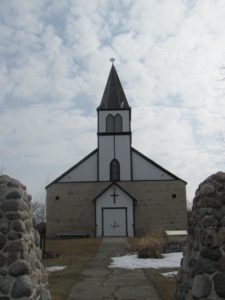 Summer services are held in the church on Sunday’s, and a candlelight service is held each year at Christmas time. Peguis Days are held every June where people gather to share, feast, play, and remember a time long past and the people who lived in it. Weddings and funerals occur regularly in the church and cemetery. Hundreds of people visit the church each year. Some come to attend a service, others, to visit the cemetery, and still others come to sit in the serene landscape beside the river and remember the people who once lived, worked, and enjoyed life in this beautiful place.
Summer services are held in the church on Sunday’s, and a candlelight service is held each year at Christmas time. Peguis Days are held every June where people gather to share, feast, play, and remember a time long past and the people who lived in it. Weddings and funerals occur regularly in the church and cemetery. Hundreds of people visit the church each year. Some come to attend a service, others, to visit the cemetery, and still others come to sit in the serene landscape beside the river and remember the people who once lived, worked, and enjoyed life in this beautiful place.
The Chief Peguis Heritage Park Inc. had purposed to use 35 acres of the church’s 65 acres parcel to create a theme park and learning centre. The vision of the park is to recreate the settlement to preserve the spiritual, cultural, and environmental importance of the site and to promote its place in Canadian history through education, interpretation and marketing. At present, the theme park is still in the planning stage.
Researched and written by Donna G. Sutherland, Historian
Historical Designation
St. Peter’s was designated a provincial heritage site in 1963.
Sources
Primary Sources
Archives of Manitoba – The Journal of William Cockran
Archives of Manitoba – The Journal of Abraham Cowley
Diocese of Rupert’s Land Archives, Winnipeg, Manitoba
Hudson’s Bay Company Archives, Winnipeg, Manitoba
Secondary and Publishes Sources
Butterfield, David Architectural Heritage: TheSelkirk and District Planning Area (Manitoba Culture, Heritage and Recreation, 1988)
Cherney, Bruce “Land surrender obtained through duplicity of officials,” Heritage Highlights (Friday, 22 November 2002), p. 4-5.
Johnson, Dennis F. Inland Armada: The York Boats of the Hudson’s Bay Company (Lower Fort Garry Volunteer Association, 2005)
MacDonald, Graham, A Good Solid Comfortable Establishment: An Illustrated History of Lower Fort Garry (St. Andrews: Lower Fort Garry Volunteer Assoc., 1992)
Manitoba Conservation, Geographical Names of Manitoba (Government of Manitoba, 2000)
Northern Lights Heritage Services Inc. St. Peter Dynevor Old Stone Church HRIA: Monitoring Component (Unpublished articles: September and November, 2002)
Rural Municipality of St. Clement’s (Shirley Herda & Associates) The East Side of the Red; A Centennial Project of the Rural Municipality of St. Clements 1884 to 1984, “St. Peter’s Church, Dynevor” (St. Clements, 1984) P. 189-193
—– St Peter’s Dynevor Old Stone Church (Unpublished report, St. Clements Heritage Building Inventory, 1999)
McRae, Brenda, “Duncan McRae: ‘A Community Builder’ in Family Connections: The 2005 Red River Descendants Reunion edited by Judith Hudson Beattie, Barbara Gessner, Shirlee Anne Smith, Donna G. Sutherland (St. Andrews: Lower Fort Garry Volunteer Assoc., 2009)
Sutherland, Donna G. Peguis; A Noble Friend (St. Andrews, Chief Peguis Heritage Park Inc, 2003)
—–Nahoway; A Distant Voice (Petersfield: White Buffalo Books, 2008)
Thompson, Albert Edward (Chief) Chief Peguis and his Descendants (Winnipeg: Peguis Publishers, 1973)
Websites
Catholic Online (Saints and Angels) at: www.catholic.org
Dictionary of Canadian Biography – Library and Archives Canada “Rev. Abraham Cowley” at: http://www.biographi.ca/009004-119.01-e.php?BioId=39570
Dictionary of Canadian Biography “Rev. William Cockran,” at: http://www.biographi.ca/009004-119.01-e.php?BioId=38480
Dictionary of Canadian Biography “Peguis” at: http://www.biographi.ca/009004-119.01-e.php?BioId=38772
History of the Whitechapel Bell Foundry at: http://www.whitechapelbellfoundry.co.uk/foundry.htm
Historic Resources, Provincial Heritage Site No. 7 – Dynevor Rectory at: http://www.gov.mb.ca/chc/hrb/prov/p007.html
Hudson’s Bay Company Archives “Ships’ Logs” at: http://www.gov.mb.ca/chc/archives/hbca/resource/ship_rec/c1c.html
John Taylor & Co. (Loughborough Bell Foundry) at: http://www.taylorbells.co.uk/
KildonanPresbyterian Cemetery” at: http://www.kildonanpresbyteriancemetery.com/
Library and Archives Canada, Administrative History/Biographical of St. Peter’s, Dynevor at: www.archivescanada.ca
Little Britain United Church” at: http://littlebritainunitedchurch.ca/
Manitoba Heritage Council Commemorative Plagues athttp://www.gov.mb.ca/chc/hrb/plaques/plaq0754.html
Manitoba Historical Society “Henry Prince (Red Eagle)” at: http://www.mhs.mb.ca/docs/people/prince_h.shtml
Manitoba Historical Society,
“The Rev. William Cockran: The Man and the Image,” at: http://www.mhs.mb.ca/docs/mb_history/33/cockran_w.shtml
Manitoba Historical Society “Peguis” at: http://www.mhs.mb.ca/docs/people/peguis.shtml
Manitoba Provincial Heritage Site No. 54 “St. Andrews-On-The-Red Church at: http://www.gov.mb.ca/chc/hrb/prov/p053.html
Netley Marsh Waterfowl Foundation’ at: http://www.lssd.ca/netleymarsh/
New Advent (Catholic Encyclopedia) at: www.newadvent.org
Parks Canada, York Factory National Historic Site of Canada at: http://www.pc.gc.ca/eng/lhn-nhs/mb/yorkfactory/index.aspx
Peguis First Nation at: http://www.peguisfirstnation.ca/
Pinaymootang First Nation at: http://kinaabik.tripod.com/
Treaty Relations Commission of Manitoba at: www.trcm.ca
Wikipedia “Archdeacon” at: http://en.wikipedia.org/wiki/Archdeacon
Wikipedia “Assiniboine” at: http://en.wikipedia.org/wiki/Assiniboine
Wikipedia “Atlantic Ocean” at: http://en.wikipedia.org/wiki/Atlantic_Ocean
Whitechapel Bell Foundry at: http://www.whitechapelbellfoundry.co.uk/
Wikipedia “bell tower” at: http://en.wikipedia.org/wiki/Bell_tower
Wikipedia “block and tackle’ at: http://en.wikipedia.org/wiki/Block_and_tackle
Wikipedia “Cathedral of St. John” at: http://en.wikipedia.org/wiki/Cathedral_of_St._John_(Winnipeg)
Wikipedia “Chillingham, Northumberland at: http://en.wikipedia.org/wiki/Chillingham,_Northumberland
Wikipedia “Cree” at http://en.wikipedia.org/wiki/Cree
Wikipedia “Christianity” at: http://en.wikipedia.org/wiki/Christianity
Wikipedia “Church Missionary Society’ at: http://en.wikipedia.org/wiki/Church_Mission_Society
Wikipedia “Deacon” at: http://en.wikipedia.org/wiki/Deacon
Wikipedia “Fairford, England” at: http://en.wikipedia.org/wiki/Fairford
Wikipedia “Francis Rice, 5th Baron, Dynevor at: http://en.wikipedia.org/wiki/Francis_Rice,_5th_Baron_Dynevor
Wikipedia “Fur Trade” at: http://en.wikipedia.org/wiki/Fur_trade
Wikipedia “Georgian architecture” at: http://en.wikipedia.org/wiki/Georgian_architecture
Wikipedia “Half-breed” at: http://en.wikipedia.org/wiki/Half-breed
Wikipedia “Hudson Bay” at: http://en.wikipedia.org/wiki/Hudson_Bay
Wikipedia “Hudson’s Bay Company” at: http://en.wikipedia.org/wiki/Hudson%27s_Bay_Company
Wikipedia “King Charles II of England” at: http://en.wikipedia.org/wiki/Charles_II_of_England
Wikipedia “Lake Winnipeg” at: http://en.wikipedia.org/wiki/Lake_Winnipeg
Wikipedia “lime kilns” at: http://en.wikipedia.org/wiki/Lime_kiln
Wikipedia “Limestone” at http://en.wikipeda.org/wiki/Limestone
Wikipedia “Lord Selkirk” at: http://en.wikipedia.org/wiki/Thomas_Douglas,_5th_Earl_of_Selkirk
Wikipedia “Métis People” at: http://en.wikipedia.org/wiki/M%C3%A9tis_people_(Canada)
Wikipedia “mortar” at: http://en.wikipedia.org/wiki/Mortar
Wikipedia “North West Company” at: http://en.wikipedia.org/wiki/North_West_Company
Wikipedia “Ojibwe” at: http://en.wikipedia.org/wiki/Ojibwe
Wikipedia “Red River Colony’ at: http://en.wikipedia.org/wiki/Red_River_Colony
Wikipedia “Rupert’s Land” at: http://en.wikipedia.org/wiki/Rupert%27s_Land
Wikipedia “Saulteaux” at: http://en.wikipedia.org/wiki/Saulteaux
Wikipedia “Sault Ste. Marie” at: http://en.wikipedia.org/wiki/Sault_Ste._Marie,_Ontario
Wikipedia “shake/shingle” at: http://en.wikipedia.org/wiki/Shake_(shingle)
Wikipedia “Stonemasonry” at: http://en.wikipedia.org/wiki/Stonemasonry
Wikipedia “Stornoway” at: http://en.wikipedia.org/wiki/Stornoway
Wikipedia &ldqnbsp; uo;Upper Canada” at: http://en.wikipedia.org/wiki/Upper_Canada
Wikipedia “Upper Fort Garry” at: http://en.wikipedia.org/wiki/Fort_Garry
Wikipedia “York boats” at http://en.wikipedia.org/wiki/York_boat
Wikipedia “York Factory, Manitoba” at: http://en.wikipedia.org/wiki/York_Factory,_Manitoba

